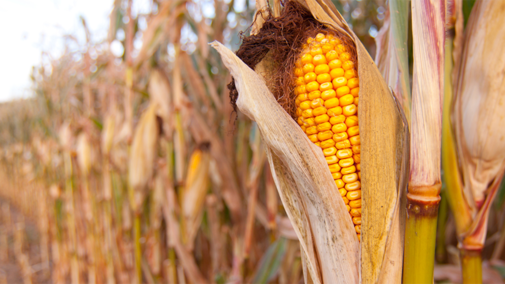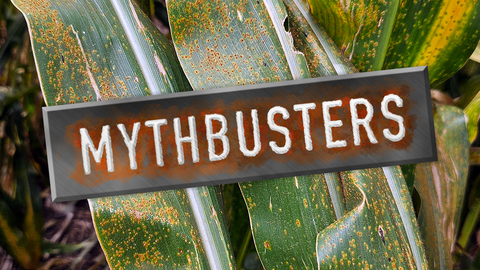
Nebraska Corn Production
Corn is the most economically important crop grown in Nebraska, resulting in $8.6 billion from 9.5 million acres harvested in 2023, according to USDA National Agricultural Statistics Service.
- Nebraska ranks 3rd in U.S. corn production.
- Nebraska ranks 2nd in U.S. popcorn production.
- Nebraska ranks 1st in U.S. white corn production.
- Nebraska ranks 2nd in U.S. ethanol production capacity.
- Nebraska ranks 2nd in U.S. corn production for distillers grains.
- Nebraska ranks 1st in U.S. corn production for cattle feed.

Corn Production Resources
Corn Planting Resources
- University of Nebraska–Lincoln Hybrid Maize Model — A computer program that simulates the growth of a corn crop under non-limiting or water limited (rainfed or irrigated) conditions based on daily weather data.
- Check out the Corn Growth and Development publication from Iowa State University Extension, with information for today's hybrids and excellent graphics.
- Planting Tips for Successful No-till — April 2011 CropWatch article.
- Corn Growth and Development — article on national eXtension site.
- How a Corn Plant Develops (Iowa State University Publication)
- Corn Planting Article — eXtension April 2010.
- Planting Considerations — CropWatch article on how to no-till corn into corn residue.
- Consideration of Dryland Corn Seeding Rate after a Season of Severe Drought — 2012 CropWatch article.
- Recommended Seeding Populations for Western Nebraska Dryland Corn — 2012 CropWatch article.
- Corn Planting Dates and Planting Populations — April 2010 Crop\Watch article. Also view the related 2011 On-farm Research Powerpoint presentation.
- UNL Research: Skip Row Corn Reduces Risk for Western Nebraska Growers — 2012 CropWatch article.
- How Corn Planting Date Affects Yield — April 2009 CropWatch.
- Corn Planting Depth — April 2010 CropWatch.
- Choosing the Right Tillage System for Row Crop Production — This NebGuide systematically considers 19 criteria, in addition to the cost of conversion, in choosing a tillage system for your farming operation.
- Soil Temperature: A Guide for Planting Agronomic Crops in Nebraska
- Using Starter Fertilizers for Corn, Grain Sorghum and Soybeans — Starter fertilizer may increase early growth of corn and gain sorghum, but increased early growth often does not translate to increased grain yield. Starter fertilizer may be of the most benefit under reduced tillage, on irrigated sandy soils and on high pH soils.
- Land Measure — Lancaster County fact sheet.
In-Season Resources
The following are resources available for in-season production issues.
- Evaluating Corn Stands — May 2009 CropWatch article.
- Corn Leaf Burn from Sidedressing Anhydrous Ammonia — May 2009 CropWatch article.
- Application Tips to Avoid Leaf Burn — 2012 CropWatch article
- Ammonia Root Burn on Corn — June 2009 CropWatch article.
- Fertilizer Suggestions For Corn (EC117) — Fertilizer nutrient requirements for corn are based on expected yield and nutrient levels in the soil.
- Except for Iron and Zinc, Application of Micronutrients Often Not Warranted — 2012 CropWatch article.
- Site-Specific Nitrogen Management for Irrigated Corn — Describes several approaches to site-specific nitrogen management including data collection, soil sampling and nitrogen recommendations as well as a history and economic analysis of the practice.
- Remote Sensing in Site-Specific Management: Precision Agriculture (EC702)
- Seedling Diseases Developing in Corn
- Sampling for Nematodes in Corn
- Aphids in Corn and Sorghum
- 2nd Generation ECB Scouting Spreadsheet Online
- Begin Scouting for Western Bean Cutworm Eggs
- Western Corn Rootworm and Japanese Beetle Adults Becoming Active
- Stink Bugs Reported in Corn and Soybeans
- Forecasting Stalk Borer Growth Stage
- Corn Rootworm Larval Scouting and Postemergence Treatments
- Spidermites in Field Corn or Soybean
- Irrigation Management for Corn — This NebGuide discusses corn irrigation management strategy options and objectives.
- Surviving High Input Costs in Crop Production — A compilation of fact sheets, each of which describes how a change in farming practice can increase profit by a minimum of $2 per practice. Topics range from management strategies for inputs and pests to tillage and irrigation.
- How Extended High Heat Disrupts Corn Pollination — July 2011 CropWatch article.
- Shallow Rooted Corn: Will Corn Continue to Root Down After Tassel? — 2010 CropWatch article (also view Market Journal segment).
- Scout for Stalk Rots — September 2010 CropWatch.
- Harvesting Crop Residues (G1846) — Issues of crop residue harvest, including nutrient removal and effects on erosion, soil quality, water loss, and yield are discussed in this NebGuide.
- Tip Dieback and Zipper Ears in Corn — 2010 Ohio State University article.
- Abnormal Corn Ears Poster — Ohio State University.
- The Use and Pricing of Drought-Stressed Corn — This NebGuide explains how to identify drought stress in corn, estimate potential yield, select for forage or grain harvest and establish prices. Details four forage options and the potential for nitrate poisoning.
Corn Flooding and Storm Damage Information
The following are resources to help in your crop insurance and agronomic decisions.
- UNL Extension Flood Information Site
- Evaluating Hail Damage to Corn (EC126)
- How Corn Plants Respond to Flooding — May 2011 CropWatch article.
- If You Decide to Replant Corn, What Comes Next? — May 2011 CropWatch article.
- Crop Damage and Grower Loss-Addressing Both Fronts — July 1, 2010.
- Flood Recovery Programs Available From USDA’s Farm Service Agency — June 23, 2010.
- Weed Control, Nitrogen Loss Among Challenges Facing Farmers with Soggy Fields — June 23, 2010.
- Flood-plagued Farmers Need to Move Quickly but Carefully — June 21, 2010 IANR News.
- Unknown Soil Nitrogen Losses: What to Do? — June 18, 2010 CropWatch.
- Crop Insurance Impacts of Recent Flooding — June 15, 2010 CropWatch.
- Crop Management Information for Flood-Damaged Field Crops — a comprehensive, multi-state list of information resources and links related to flood-damaged field crops, developed by Purdue University Department of Agronomy.
- Extension Disaster Education Network Flood — national Extension resources on flood damage to crops and homes; search for specific topics.
- Prevented Planting Insurance Provisions: Flood — a USDA Risk Management Agency (RMA) fact sheet.
- How to File a Crop Insurance Claim — a USDA RMA fact sheet.
- Crop Insurance Impacts from Recent Flooding — June 20, 2008 CropWatch article; reviewed June 14, 2010.
- Delayed Planting and Replanting Evaluator — an Iowa State University fact sheet.
- Delayed and Prevented Planting Provisions — an Iowa State University fact sheet.
- Good Farming Practices Protect Your Investment in Crop Insurance — a USDA RMA fact sheet.
- Assessing Hail Damage to Corn National Corn Handbook
- Pummeled Corn Vulnerable to Disease Development — June 2010 CropWatch.
- Fungicide Use in Corn After Hail Events and Prior to Tassel — June 2010 CropWatch.
Storage, Grain Drying, Blending and Mycotoxin Issues
- UNL Drought Resources website
- Managing Large Grain Bins for Potential Mycotoxin Contamination
- How to Estimate How Much Grain is in a Bin
- Blending Grain and Feedstuffs: How to Figure the Proper Proportions — This NebGuide will demonstrate how to use a Pierson square to determine the precise proportions of grain or feedstuff required to create a blend.
- Understanding Fungal (Mold) Toxins (Mycotoxins)
- Use of Feed Contaminated with Fungal (Mold) Toxins (Mycotoxins)
- Sampling and Analyzing Feed for Fungal (Mold) Toxins (Mycotoxins)
- Emergency/Temporary Grain Storage: Unconstrained Piles of Grain — Extension in Lancaster County fact sheet.
- Cool, Wet Weather has Slowed Corn and Soybean Drying, No Relief in Sight — October 2009 CropWatch.
- Cool Grain to Avoid Runaway Deterioration — October 2009 CropWatch
- Drying Times for Binned Corn with Natural Aeration — October 2009 CropWatch
- UNL Extension Lancaster County Grain Drying Web Site
- Monitoring Natural Air Corn Drying-A Demonstration Project
- Recommendations for Monitoring Stored Grain in February — February 2010 CropWatch.
- Monitoring Stored Grain in March
- Drying Times for Binned Soybeans with Natural Aeration
- Preparing Bins and Equipment for Pest Free Storage — 2011 CropWatch.
- Tips for Monitoring Stored Grain this Fall and Winter to Maintain Quality — 2012 CropWatch.
- Mycotoxins & Aflatoxins, USDA Grain Inspection, Packers and Stockyards Administration (GIPSA).
- Scout Fields for Aspergillus Ear Rot to Avoid Losses due to Aflatoxin Contamination
- FDA Action Levels for Aflatoxins in Animal Feeds




